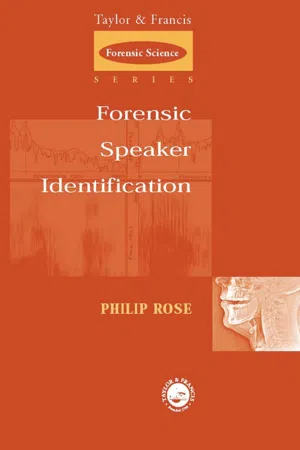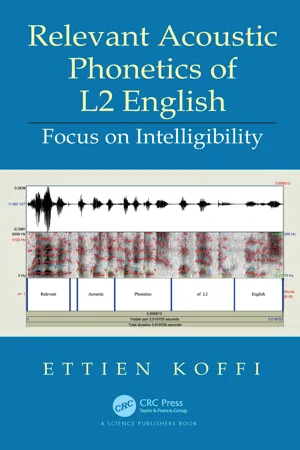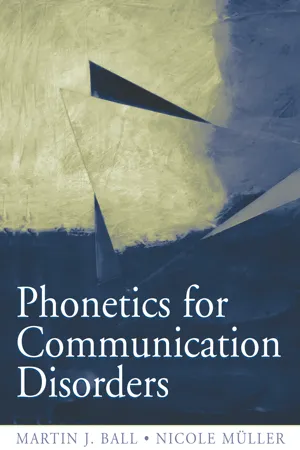Languages & Linguistics
Nasal Sound
Nasal sound refers to a type of speech sound produced by allowing air to escape through the nose while the mouth is closed. This results in a distinctive resonance and quality to the sound. In phonetics, nasal sounds are typically represented by specific symbols and are found in various languages around the world.
Written by Perlego with AI-assistance
6 Key excerpts on "Nasal Sound"
- eBook - ePub
- Bruce M. Rowe, Diane P. Levine(Authors)
- 2022(Publication Date)
- Routledge(Publisher)
pharyngeal sound. These are just some of the many additional possibilities for places of articulation.Consonants: manner of articulation
The airstream can be obstructed at any place along the vocal tract. However, you will note that many sounds can be articulated at about the same location. For instance, there are five egressive voiced alveolar sounds in English. They must differ in some other characteristic. The additional difference is the manner in which the airstream is constricted or released within the vocal tract.Nasals are produced in both the nasal and oral cavities. Most sounds in English are produced through the oral (mouth) cavity. This occurs because during speech, the velum (soft palate) is usually in a raised position, blocking the airstream’s passage into the nasal cavity. The resultant sounds are called oral because the oral cavity is used as the sole resonating chamber. However, if the velum is lowered, air can escape through both the oral and nasal cavities. The sound that results is called nasal. There are only three nasal consonants in English: the initial sound in mad [m] (bilabial) and nose [n] (alveolar), and the final sound in sing [ŋ] (velar).When you have a cold, people may comment that you sound nasal. However, if your nose is completely blocked, then you cannot produce Nasal Sounds. All your sounds would be oral, and it would be more accurate to label your speech as oral, not nasal. For instance, when your nose is blocked, the utterance “How come I sound so funny?” becomes “How cub I soud so fuddy?” The oral [b] sound is substituted for the nasal [m], and the oral [d] sound is substituted for the nasal [n] sound. The only difference between [b] and [m], as well as [d] and [n], is that the first sound is oral and the second is nasal. - eBook - ePub
- Phil Rose(Author)
- 2002(Publication Date)
- CRC Press(Publisher)
Of these, nasalisation, length and dynamicity are the most important. Nasalisation The idea behind vowel nasalisation is simple, and has already been mentioned in the section dealing with the nasal cavity. Normally, vowels are produced with the oral and pharyngeal cavities acting as resonators. We have seen that the soft palate governs access to the nasal cavity. Lowering the soft palate in vowel production means that the additional resonances of the nasal cavity will be combined with those from the pharynx and oral cavities, and a set of very different sounding nasalised vowels can be produced. Traditional phonetic description uses the label of nasalised (as opposed to oral) for a vowel that sounds as if it has been produced with the soft palate down. One nasalised vowel that is common in English can be heard at the end of some people’s pronunciation of the word restaurant. Other examples of nasalised vowels were given above. The implementation of nasalisation in reality is considerably more complex than this, and digressing a little to explain how offers the chance to say something informative about speech perception. Because the tongue body is attached, by muscles, to the soft palate, a low position of the tongue body, as in open vowels, tends mechanically to pull the soft palate open (this can be seen by comparing soft palate height in the [i] and [ ] vowel X-rays, Figures 6.11 and 6.12 above). This introduces the acoustic effects of nasalisation. However, because a certain amount of acoustic nasalisation is expected to occur automatically with open vowels as a function of the mechanical coupling between tongue body and soft palate, the perceptual mechanism ignores it when deciding whether to perceive the vowel as nasalised or not - eBook - ePub
Relevant Acoustic Phonetics of L2 English
Focus on Intelligibility
- Ettien Koffi(Author)
- 2021(Publication Date)
- CRC Press(Publisher)
Vowel nasalization in nasal contexts is very widespread. The phonetic transcriptions of L2 Englishes provided by the SAA website shows that the L2 speakers do not have any problem nasalizing their vowels. Ladefoged and Maddieson (1996:102, 104) explain that some languages nasalize vowels more heavily than others. This means that a larger quantity of air flows through the nostrils than through the oral cavity. French and Portuguese are often mentioned as two languages that nasalize vowels very heavily. 37 Consonant nasalization occurs to a lesser extent in English Odgen (2009:128) transcribes as [ɪ̃n̪ɣːə pɑːk] to show that [ð] is sometimes nasalized. MA 89M and MN 143M nasalize [ð] in in the phrase as [n̪]. Many speakers pronounce the in , the first in , and the last in as [n]. So, becomes [wɪñ n̪ ɚ], is heard as [ɪñ n̪ əɹɛtɪŋ̃ ], and is produced as [tʰwɛñ n̪ i]. 7.11.4 Excursus 4: Nasal Releases in the Coda When the alveolar nasal [n] appears in syllable codas, it is articulated as a separate syllable. Ladefoged and Johnson (2015:67, 71) refer to this pronunciation as “nasal plosion.” Ogden (2009:111-112) calls it “nasal release.” This pronunciation is heard when [n] immediately follows the alveolar stops [t] and [d]. Ladefoged and Johnson transcribe , , narrowly as [sædn], [sAdn], [ə] to exemplify this pronunciation. They contend that it is a mark of foreign accent if [a] is inserted between [d] and [n]. A nasal release is also heard in many pronunciations of the suffix <-ion> if the final consonant to which the suffix is added is either [ʃ] or [ʒ], as in the and . A similar pronunciation is heard often when the derivational suffix <-ism> is added to stems - eBook - ePub
- Nigel Hewlett, Janet Mackenzie Beck(Authors)
- 2013(Publication Date)
- Routledge(Publisher)
Try reading the following sentence while keeping the velum closed (if you are not aware whether your velum is open or closed, pinch your nose instead). There is, according to legend, a boiling pot of gold at one endThe effect will be something like that of speaking with a heavy cold. Speech should remain largely intelligible in this condition, although it sounds abnormal. Obviously, it is Nasal Sounds that are affected. However, the means for distinguishing between, for example, a /d/ and an /n/ are not entirely lost. A /d/ tends to have little or no vocal fold vibration during the closure in English (see chap. 8 , Waveform Types), whereas /n/ has strong vocal fold vibration during the closure; so an alveolar stop produced with strong vocal fold vibration still has a chance of conveying the presence of an /n/, even if the velum is closed.Reading the sentence with the velum open can also be done with little loss of intelligibility, although again it will sound abnormal. (Try it.) Nasalization of the vowel sounds doesn’t have a serious effect on intelligibility, as there are no phonemic distinctions between nasalized and non-nasalized vowels in English. However, the /p/ in “pot” will be awkward to pronounce.A plosive requires a build-up of pressure in the oral cavity during the closure and this is difficult to achieve when there is a leak through the nose. Hypernasality (i.e., unwanted nasality, during sounds that should be exclusively oral) sometimes occurs because the speaker has an abnormally short soft palate, which has difficulty reaching the back wall of the pharynx. Lack of nasality (hyponasality) is most commonly due to enlarged adenoids and/or tonsils, which inhibit air from flowing up through the nasal cavities.Imaging and Measurement Techniques
We can make ourselves consciously aware of the postures of our own speech organs during the production of speech sounds (although this is most true of the lips and of the forward part of the tongue and least true of what goes on in the pharynx). This ability has been immensely useful for describing the different speech sounds of languages but it has obvious limitations. Experimental techniques have been developed for imaging and measuring the articulatory gestures of speech. Many of these allow measurement and imaging of continuous speech. - eBook - ePub
- F.C. Stork, J.D.A. Widdowson(Authors)
- 2014(Publication Date)
- Routledge(Publisher)
A lateral sound is produced by allowing the air to pass around one or both sides of an obstruction along the centre line of the oral cavity. In the articulation of [l] the apex of the tongue meeting the alveolar ridge prevents the air from escaping along the central line and forces it to pass around the sides or latera of the tongue. Some languages have DENTAL sounds rather than alveolar. In English the stop consonants [t] and [d] are produced with the apex of the tongue on the alveolar ridge, but in Russian, for example, the apex of the tongue is behind the top teeth and the sounds [ ] and [ ] occur. English has fricative sounds [θ] and [ð] which are produced with the tongue coming into contact with the teeth. Since both the top and the bottom teeth may be involved in the articulation of these sounds, they are often referred to as INTERDENTAL FRICATIVES. The top teeth and the lips come together to form LABIODENTAL sounds. English has the voiced and voiceless fricatives [v] and [f] in this position. BILABIAL sounds are produced by the interaction of both lips. English has only voiced and voiceless stops [b] and [p] in this position, but some languages have fricatives. Spanish, for example, has a voiced bilabial fricative [β]. After passing the lips the air has reached the outside world via the oral cavity, but there is an alternative route. If the velum is lowered to allow air to escape via the nose, NASAL consonants will result instead of the ORAL consonants described above. In the case of a nasal consonant air escapes only through the nose and the airway is blocked completely at some point in the oral cavity. Bilabial [m], alveolar [n], velar [η] occur in English but in some other languages labiodental, dental, palatal, retroflex and uvular nasal consonants also occur - eBook - ePub
- Martin J. Ball, Nicole Muller(Authors)
- 2014(Publication Date)
- Psychology Press(Publisher)
Fig. 6.2 ). So no air pressure builds up, and there is no plosion. However, even though airflow is through the nasal cavity, the constellation of articulators in the oral cavity is still important. Because the oral and nasal cavities are linked via the pharynx and the velopharyngeal port, the sound quality of the nasal stop is made up of all the resonances imparted to the airflow as it passes through all these cavities. This can be heard if we hum a long, prolonged [m] sound and compare that with an [n] sound. They differ. This difference can only come from the effect of the altered size of the oral cavity: [m] has a larger oral cavity than [n], because for [m] the closure is at the lips, whereas for [n] it is between the tongue tip and the alveolar ridge.FIG 6.2. Nasal stop production (solid line: passive articulator; dotted line: active articulator; arrows: airflow).When we make nasal stops, we tend to lower the velum a little in advance of the beginning of the stop itself (i.e., the closure of the articulators). This results in any sound coming before the nasal stop becoming somewhat nasalized. If you listen closely to the [i] vowel in the word “seed” and compare it with the same vowel in the word “seen,” you should be able to hear the somewhat nasalized quality of the latter. At the end of the nasal stop, there may also be an amount of nasalization on the following sound, as it takes a certain amount of time to raise the velum again. This does not appear to be so strong, however, and phoneticians generally consider that anticipatory coarticulation (as they call it) is stronger than persevatory coarticulation (see also discussion of coarticulation in chap. 9 ).In the languages of the world, nasal stops are very common (though there are a few languages that lack them, including Rotokas—an Indo-Pacific language). However, in the overwhelming majority of languages, only voiced nasal stops are found. This is probably because voiceless nasals are not very loud, and those languages that have them may well add voicing toward the end of the sound in order to add to the sound's salience. Some southeast Asian languages, such as Burmese, have voiceless nasals.
Index pages curate the most relevant extracts from our library of academic textbooks. They’ve been created using an in-house natural language model (NLM), each adding context and meaning to key research topics.
Explore more topic indexes
Explore more topic indexes
1 of 6
Explore more topic indexes
1 of 4





